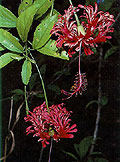By Heidi Bornhorst
An old-fashioned and lovely hibiscus is the coral hibiscus. It came to our islands from Africa. It is the parent of many wonderful hibiscus cultivars and varieties.
 |
| The coral hibiscus is easy to grow. You can use cuttings or buy one of the plants at a garden shop.
W. Arthur Whistler |
Grace Dixon, a well-known volunteer for the Honolulu botanical gardens and the Friends of Wahiawa Library, calls it the lacy snowflake hibiscus, which is a great name, don’t you think? Each flower is lacy in profile and unique like a snowflake.
The flowers are an orange coral color, with white highlights on the petals, as described by this usual common name, the coral hibiscus. They are pendant on the plant when they bloom. Scientists call it Hibiscus schizopetalus. It makes a great hibiscus parent plant for hybridizers to work with and create new hybrids and cultivars. My parents have an old-fashioned hybrid that is a velvety red with flowers somewhat pendant. The "parents" of this hybrid were the coral hibiscus and one of the native Hawaiian red hibiscus, known in Hawaiian as koki‘o‘ula.
One of our most commonly seen, beautiful, tough and drought-tolerant hedge-type hibiscus also has the coral hibiscus and a native Hawaiian as parents. We call this striking pink-flowered variety the "pink waterfall" or "pink butterfly" hibiscus. Its parents were the coral hibiscus and the fragrant, native Hawaiian white with a pink staminal column, Hibiscus arnottianus. Both parents have some drought tolerance, especially the coral hibiscus, and their keiki are very tough and can take pretty dry conditions once the plant is mature and well established in the ground.
The hedges can get quite tall and are very striking with their masses of pink flowers. You see this one around quite a bit in people’s gardens, along the freeway and in hotel and resort plantings. It can be grown as a very striking specimen plant, as well as the more commonly seen hedge. Some people like the pink waterfall as a stock plant for grafting other hybrids onto. Its tall straight stems lend well to this purpose, and you can grow a standard or upright plant on a tall stem with the grafting technique.
Unlike its keiki, you do not see the coral hibiscus around very much. We grow it in botanical gardens like forest and at Waimea Arboretum, but we should grow it more in our gardens. I got a call the other day from noted Hawaiian artist and designer Nake‘u Awai, lamenting that we don’t see coral hibiscus much anymore.
"As people develop and build big houses, they dig out the coral hibiscus. I remember as a kid, people had hedges of coral hibiscus that were 30 feet tall! What a beautiful work of art the coral hibiscus is," he said.
The coral hibiscus is easy to grow and well worth the effort. If you can find it in an old kama‘aina garden, ask nicely for a cutting. Cuttings of semi-hard wood, 6 inches to 1 inch in length, grow well. Start them in a clean pot of potting mix and water daily, or several times a day if you can, to get them started.
You can transplant them to a large pot, or into the ground, in a few months, after they have rooted. They prefer moist but well-drained soil in sunny or partly sunny locations. You can sometimes find coral hibiscus in landscape nurseries, or ask your garden shop to find a plant for you.
Heidi Bornhorst is the director of the city’s five botanical gardens: Foster, Lili‘uokalani, Wahiawa, Koko Marina and Ho‘omaluhia. She also is the host for a gardening segment at 5:30 a.m. Tuesdays on KITV.
[back to top] |

 The Great Index to Fun
The Great Index to Fun